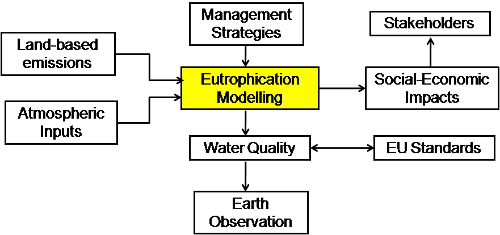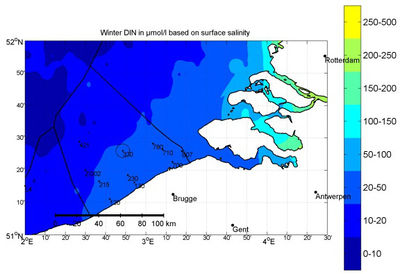Nutrient loading of coastal waters
Contents
Introduction
Eutrophication has the growing attention of the regional and international community, and has been studied extensively during the past decades. The quality of marine waters is monitored continuously by means of water samples (in-situ data) and satellite observation. A remaining challenge is to improve the scientific guidance of management strategies to reduce eutrophication in the marine environment. Scientific simulation models of eutrophication processes are valuable tools used to aid scientific understanding in addition to field and satellite data and to guide management decisions. Models can be used to analyze the causes and consequences of eutrophication and predict bloom events. Integrated models are the first choice, because eutrophication is the result of complex interactions between human activities, hydrodynamics, and ecological processes.
Use of models in eutrophication management
Introduction
European countries have committed themselves to the OSPAR Convention of 1992, with the objective to reduce the input of nutrients coming from different sources such as agriculture, industry, waste water by 50% compared to the 1985 level. Another objective is to achieve a water quality which is not exceeding a level which is 50% above the minimum level corresponding to the pristine situation without human interference. Models are important tools for identifying and ranking sources of eutrophication. They also contribute to forecasting future impacts of different management strategies on marine water quality. The role of eutrophication models is schematically depicted in Fig. 1.
Land-based emissions
With models it is possible to find out which sectors contribute most to the loading of nutrients to the coastal waters under various scenarios (e.g. reductions in the size of the cattle stock, less use of fertilizers, or a combination,...). They also make it possible to estimate the effectiveness of reducing the input of nutrients from various sources, for example to reduce the risk of spring algal blooms. An example is shown in Fig. 2, showing the effectiveness of reducing the nutrient loading from the Scheldt catchment for the average winter values of dissolved inorganic nitrogen in the southern North Sea.
Atmospheric inputs
An important source of nutrients responsible for the growth of algae in coastal waters are pollutants (especially nitrogen oxides NOx) emitted from human activity in cities, from land and sea transport networks and from industry. Transported by the wind, they reach the coast where they are deposited, especially by rainfall during the winter months preceding algal bloom events. To demonstrate the effect of atmospheric transport of algal nutrients to the coastal waters computer models can be used that comprise the elements: (1) the physics of transport and deposition, (2) the sources responsible for the emissions and (3) the weather data (wind speed and direction, rainfall, temperature, etc...). Fig. 3 shows a simulation result from a transport-deposition model combining weather data and emissions data. Computed quantities of nitrogen oxides deposited over the Channel - southern North Sea region in April 2009 are shown as colour contours. It can be seen that the coastal waters of the Netherlands (which also have the highest riverine input) are most strongly affected by such atmospheric deposits, followed by the Eastern English Channel which receives input not only from the neighbouring land but also from shipping.
 Fig. 3a. Emissions of nitrogen oxides. Source EMEP |
See also
References
- Georgi Djambazov (2013). Atmospheric modelling for ISECA. Project communication doc.
- Jean-Luc de Kok (2013). Modelling marine and coastal eutrophication. Project communication doc.
Please note that others may also have edited the contents of this article.
|



